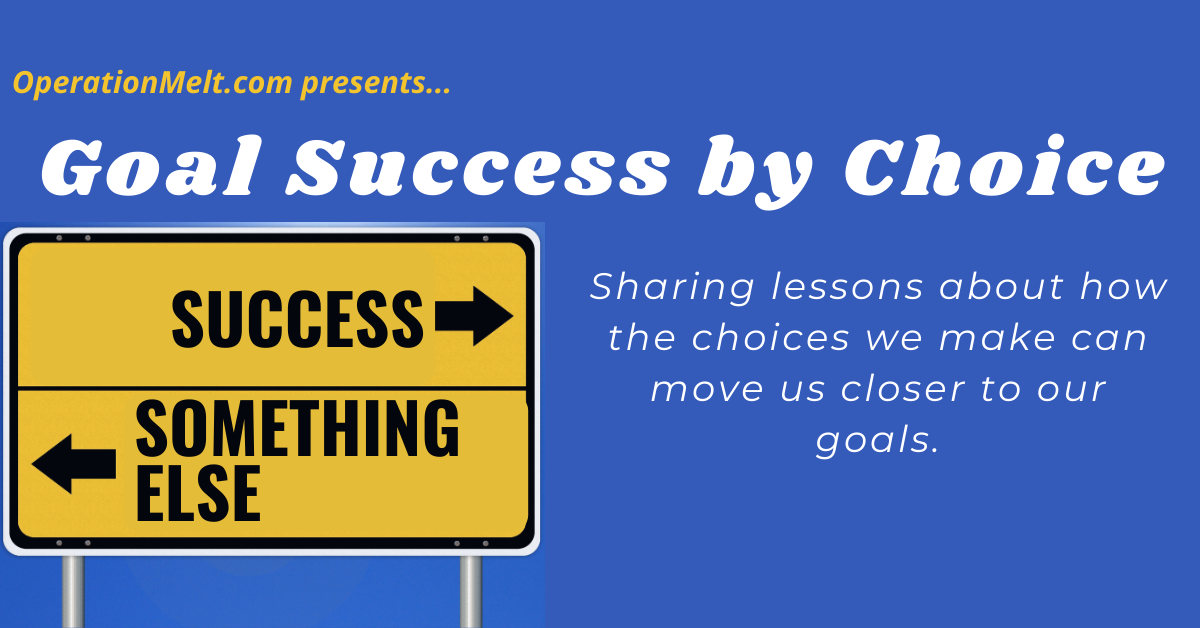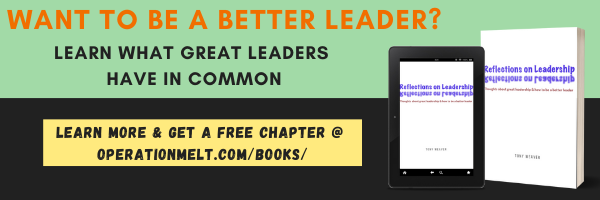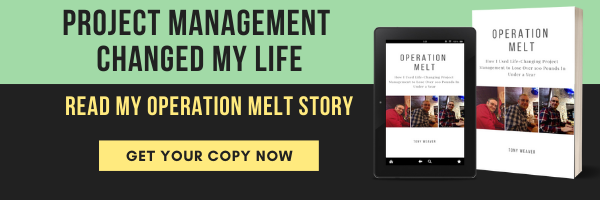Do you have dreams that you are trying to make come true? Do you have a goal that you are trying to crush? Success doesn’t happen by chance. Success is a series of choices that can make you unstoppable. Goal Success by Choice helps you make these choices to move you closer to your goals. Are you ready to help build a world where no goal dies of loneliness?
Amuse Bouche
Before we get to today’s post, I offer you this light “amuse-bouche” to entertain your mind before we get down to business. Like any other amuse-bouche, you may hate my “dad joke,” but it is worth every penny that you paid for it, right?
A priest, a pastor and a rabbit went to a blood drive. The nurse asked the rabbit: “what is your blood type?” “I am probably a type O” answered the rabbit.
6 steps to never saying “I’m too busy” again
It is not enough to be busy; so are the ants. The question is: What are we busy about?
Henry David Thoreau
I hate the phrase “too busy” with a passion!
Being “too busy” is a choice and often an excuse. Fear, uncertainty, lack of knowledge (including self-knowledge) and lack of direction in our lives often masquerade as “too busy.”
Today, I will share six strategies that can help put you back in the driver’s seat of your life and never say “I’m too busy” when it comes to your biggest goals and dreams. These strategies aren’t just productivity hacks; they are proven tools to change your life.
Read on if you are ready to learn to stop being “too busy” and want to start crushing some goals.
Triggered
You may be saying to yourself, “Hey, haven’t you written about being too busy before?” Great memory, and thanks for being a long-time reader! Yes, I have addressed this topic before in a few blog posts. I talked about being “too busy” in my first book, Operation Melt: How I Used Life-Changing Project Management to Lose Over 100 Pounds in Under a Year. Plus, I share another perspective about “too busy” as it applies to leaders in my upcoming book, Reflections on Leadership. But, I am talking about it again today for three reasons:
- I haven’t addressed it in quite a while and never in this particular way
- I am very passionate about the impact “I’m too busy” has on goals dying of loneliness
- I recently got triggered and haven’t stopped thinking about this topic since
Here’s a quick story about how I was triggered.
I recently reconnected with a former colleague that I hadn’t talked to in more than a year. Because of the pandemic around us, and because I had COVID myself when I reconnected with her, I thought an in-person reconnection wasn’t the best choice. Instead, I chose LinkedIn as the platform for our reconnection.
We exchanged pleasantries and then shared how we are spending our time and our current work situations … like you do. I explained that I am still in project management consulting as my primary job and in my third year with my current client, whom I adore. But, consulting is just one facet of my overall portfolio of things I do as I pursue my mission of helping people achieve their goals. As you know, I have also launched my coaching business, continue to publish a weekly blog, and my second book is about to be released. I am also pursuing many fitness goals (walking, running, lifting), though COVID recovery has been a slight setback.
She read this, looked at my profile and then said, “wow, you are a busy guy!” and went on to ask how I fit all of that in and still sleep.
The truth is, I don’t feel like I have a busy life at all. In addition to all of the things I told my friend, I also find plenty of time to hang out and watch television with my wife. We go out to restaurants and see friends all the time. I have plenty of time to do the things that I want to do, and I sleep, and I have downtime.
But, this conversation was all it took to trigger me and my hatred of “too busy,” so here we go. I want to help purge “I’m too busy” from our collective vocabulary. Once we do, just imagine all the things we can accomplish.
Busy Isn’t Real, But It’s Really Dangerous
The mind-blowing fact about “too busy” is that it isn’t actually real.
There is no scientific, empirical scale by which “busy” can be measured. Further, every quantitative study of being “busy” has revealed that we are objectively less “busy” than we have been for decades. Granted, these were pre-COVID surveys, but probably still pretty accurate. For example, one study concluded that average weekly work hours had declined steadily for a century. In 1970 they leveled out at the forty-hour workweek we have today and haven’t materially changed ever since.
This means that “busy” isn’t a real, tangible thing. “Busy” is a feeling and something that we have constructed in our own minds. There are a plethora of reasons that we feel busier:
- Our general pace of life
- The ubiquity of distractions
- Multi-tasking (which our brains scientifically cannot do)
- General social pressures created by FOMO and other factors
Don’t forget that being busy is also glorified and praised in our culture today. In a 2010 article, The Cult of Busy, Scott Berkun explained this cult-like behavior, especially in the workplace:
This is the cult of busy. That simply by always seeming to have something to do, we all assume a person is important or successful. It explains the behavior of many people at work. By appearing busy, others bother them less, and simultaneously believe they’re doing well at their job. It’s quite a trick.
As is often the case, if we believe something is real, it will impact us. Busy is dangerous in many ways. Feeling like you are “too busy” can significantly impact emotional health, leading to increased feelings of stress, anxiety, hopelessness, fear, and sadness. This can also lead to physical health issues, especially stress-related medical conditions. According to research shared by the American Psychological Association, “stress affects all systems of the body including the musculoskeletal, respiratory, cardiovascular, endocrine, gastrointestinal, nervous, and reproductive systems.”
Needless to say, the impact of believing you are “too busy” can be absolutely devastating. But that’s not where it stops, “too busy” is a goal killer.
A very often cited (perhaps over-cited) study from Harvard Business concluded that 83% of people never set goals for themselves. Similar studies have tried to understand why people don’t set goals. There are many common reasons why people don’t set goals, including skepticism, fear, lack of belief in themselves, laziness, and more. But, these studies commonly cite being too busy as a root cause for lacking goals.
On a side note, congratulations to my readers for being in the other 17% of people who do set goals, right?
Summarizing all of this research reinforces my core point about being “too busy.”
We choose to be too busy and then let this choice prevent us from setting and accomplishing our goals and living our best lives.
Fixing “Too Busy”
The good news is that we can make a different choice! So, let’s do that starting today.
With a few basic strategies, you can stop being “too busy” for your goals. Here are the 6 strategies:
- Change your language
- Know where your time is going
- Decide your priorities
- Identify problem areas
- Schedule time
- Progress reporting
Ok, let’s dive deeper into each of these areas. I will keep each on brief because these are simple yet life-changing strategies.
Strategy 1: Change Your Language
Want to stop saying, “I’m too busy?” Then stop saying, “I’m too busy.”
I know this seems overly simplistic and like a minor change, but it is essential.
The words we use in our lives shape our thoughts. This is why affirmations can be so powerful and negative self-talk so damaging. Your brain actually believes the things you say and interprets them as commands in a way. If you say “I’m too busy” or “I’m so busy,” your brain will work subconsciously to look for signs that prove that this is the case.
The simple analogy is when you start thinking about buying a car. If you think about purchasing a Honda Accord, you will suddenly see them everywhere you look. This is because you told your brain, “look for Honda Accords,” and you lit the fuse on your brain’s processing.
When you are tempted to say “I am too busy,” say “that’s not a priority for me” instead.
By saying that something isn’t a priority, you take ownership of your decisions instead of suggesting that external factors drive them. Plus, this phrase will cause you to actually reflect on whether it is a priority or not. But we will get to that in a minute.
Strategy 2: Know Where Your Time is Going
Next up, do you actually know where you are spending your time?
Do you know how many hours you slept, worked, commuted, exercised, ate, watched tv and such over the past month?
Spending your time is very similar to spending your money or consuming food. When you just trust it to autopilot, bad things tend to happen. Autopilot is a major contributing factor to obesity, living paycheck to paycheck, and letting your goals die of loneliness because you are “too busy” to pursue them.
If you want to stop being “too busy,” you need to switch off the autopilot, take control, and deliberate about spending your time.
Taking control starts by tracking how you are spending your time. Keep track of how you spend every hour for the next week or two. You don’t need to change anything about how you spend your time; just track it to get a good picture of where the time goes.
There are lots of ways to do this.:
- Download a time-tracking app to your phone
- Use the notes app on your phone
- Use Excel on your computer
- Use a simple notebook
Choose something that works well for you, is simple, and you will stick with consistently.
Personally, I like using a combination of tools to collect the data, and I combine it all into an Excel worksheet. I label the columns with the days of the week. I label the rows for every thirty minutes from midnight to midnight. Then, in the cells, I note the activity I was doing during that particular time.
Your time log doesn’t have to be perfect, but it needs to paint an accurate picture of where your time goes. As I said in the Your Fitness Audit chapter of my Operation Melt book:
By simply observing your behaviors, you can quickly identify the places where you need to take some action.
Strategy 3: Decide Your Priorities
Over the past four weeks, I have talked about the process for defining your goals. Here is a quick recap of the process:
- Decide where your life could use some upgrades using the Wheel of Life (see Feeling Left Out?)
- Brainstorm the possible solutions to those problems and make a list of all of the things you want to achieve. Then prioritize your list and choose one or two priority goals for the next year (see What Do You Want?)
- Figure out why these one or two priority goals are important to you (see But, Why?)
- Translate your priorities into SMART goals and create your vision for the future (see Ready for Success?)
If you haven’t completed these four steps yet, this would be the perfect time to do so. I’ll wait…
Ok, welcome back! You good now? Great!
Once you have completed this process, you will have decided on some priorities for where you want to be spending your time. This means you are ready for strategy number four.
Strategy 4: Identify Problem Areas
Welcome to strategy number four, which means we are halfway there!
So far, you have explored how you are spending your time today. You have figured out your priorities which told you where you want to be spending your time. Now, take a look at the results of both exercises side-by-side.
Are you spending your time in a way that reflects your priorities? If you have frequently been saying, “I’m too busy,” the answer is probably no. So, let’s fix that!
If you aren’t spending your time in a way that reflects your priorities, there are two possible solutions:
- Your priorities aren’t actually your priorities and need adjusted
- You need to reallocate some portion of your time to your priorities
Chances are that there is a little bit of each issue at play here, and you’ll need to spend some time on each. I know, it sounds like I am suggesting that both diet and exercise are essential for reaching your fitness goals, right?
When reviewing your time tracking log, are there places where you could possibly create some free time? Freeing up even fifteen minutes will give you some time to reinvest. But, I would recommend looking for at least an hour that could be reallocated.
There really isn’t any magic to finding this time. It will probably jump right out at you by reviewing your time log with a critical eye.
Strategy 5: Schedule Time
Once you have identified some time that can be reinvested into your priorities, it’s time to protect that time. The easiest way to ensure that time is protected is by using your favorite tool, your calendar.
For most people, the things on your calendar are absolutely going to happen. This is time that is spoken for and that you will only move deliberately. That is, you probably aren’t going to just skip an appointment on your calendar, right?
It is time to make an appointment with yourself!
On your calendar, block the time you were able to free up in strategy four. This should be a minimum of fifteen minutes, but a bigger block, such as an hour, is preferable.
Pro tip: scheduling this time when you are at your best. Ideally, target your Prime Time for your highest priority work.
After blocking your calendar, title the appointment with the name of the priority that you want to work on. This step is important because you are making an appointment with yourself to work on a specific thing. Reminding yourself of what that thing is will help you keep focused. You can take this a step further by pasting your SMART goal and your vision statement inside the body of the appointment. This way, you have everything all in one spot.
Viola! You now have a time on your calendar every day that you will commit to advancing one of your goals. That means you are no longer “too busy” to work on your goals. Plus, when you tell somebody, “that’s not a priority for me right now,” you will be telling them the truth.
Strategy 6: Progress Reporting
The final strategy is all about establishing a process to hold yourself accountable.
Just because you have defined your priorities and planned the time to focus on them doesn’t necessarily mean that you will make progress. Life happens sometimes, and our best-laid plans fall apart. But, you don’t want to discover a year from now that you didn’t make progress with your goal and that you are back to saying “I’m too busy” when you think about it.
This means that you are going to need some checkpoints along the way. These checkpoints will evaluate how you are progressing, identify issues and make necessary course corrections to address them.
It’s time to start your monthly progress report.
At the end of each month, schedule an appointment with yourself to review your progress. The agenda for this meeting is to answer the question, “how am I doing?”
- Take a look at your progress with each of your priorities. This should be pretty easy since they are measurable, SMART goals, right? Are you on track compared to your plan?
- What wins have you had this month? Write them down! Celebrate them even if you just high-five yourself.
- Have you encountered any issues, or are you facing any obstacles? How might you resolve those obstacles? What roadblocks might you face in the next few months, and how can you either avoid them or quickly solve them?
- What happened this month that you are grateful for?
- Is there anything you want to commit to doing differently in the next month? Do you need to adjust your goals?
- Do you need to start tracking your time again? Or, if you never stopped, does your time still reflect your priorities?
- Have you said “I’m too busy” during this month? If so, why? If not, there’s another high-five!
Feel free to play with this list of questions and add to it or adjust it as you see fit. But, it is best to write the questions down ahead of time and plan to write your answers down during the meeting. The more you put things on paper (or digital), the more tangible they become, and the more effective the process.
I would encourage you to make your monthly progress review meeting something fun. Maybe take yourself out for a date to your favorite restaurant, bar or coffee shop. Create some fun celebration rituals associated with your wins. Whatever it takes to make these enjoyable meetings that you look forward to is perfect. These are important meetings, and this is fun stuff. You are making your dreams come true!
Bonus Strategy: Don’t Go It Alone
The final strategy I wanted to share isn’t counted in the six. This is your bonus strategy for investing at least ten minutes into your success by reading this post. Thank you, by the way!
You don’t have to go through all of this alone!
While you are smart, talented, and definitely capable of completing these steps yourself, that isn’t always the best strategy. If you find a friend you can engage as an accountability partner to ask about your progress, you will be more likely to stick with it. Maybe you could even turn your monthly progress review into something you do together and share with the other person.
The more you can leverage a team of supporters and experts, your journey becomes more fortified. This makes you unstoppable!
Engaging a coach is another way to help get you to your destination. A coach is somebody who is trained and experienced (and likely very passionate too) in these tools and can help you set yourself up for success. They can also be your accountability partner and meet with you to review your monthly progress report. Plus, a coach can brainstorm solutions with you and can be the cheerleader to help you celebrate wins.
If you are interested in talking about how coaching could help you, please visit the Operation Melt coaching page.
Whether you leverage these strategies yourself or work with me to help you, I hope that your outcome is the same. I want you to feel confident that you are no longer “too busy” and to start living the life of your dreams.
So What?
When was the last time you said you were “too busy” to do something? More than 80% of people never set any goals, and they quote being “too busy” as one of their top obstacles. Sure, you might have a lot going on in your life right now, but being “too busy” is actually a choice. By making a few alternative choices, you can permanently banish “I’m too busy” from your life. Give these 6 practical steps a try; you just might change your life.
Need a little help getting past being too busy to make your dreams come true? I am here to help you apply these tools, to get a solid plan in place and to celebrate with you as you make your dreams come true.
Click Here to learn more about my Operation Melt coaching services.
Beware of the Robots!
Was this post helpful or interesting to you? Do you want to read more? Don’t trust it to the social media algorithms.
Defeat the robots by joining my email list below and get these posts delivered directly to your inbox every week.




